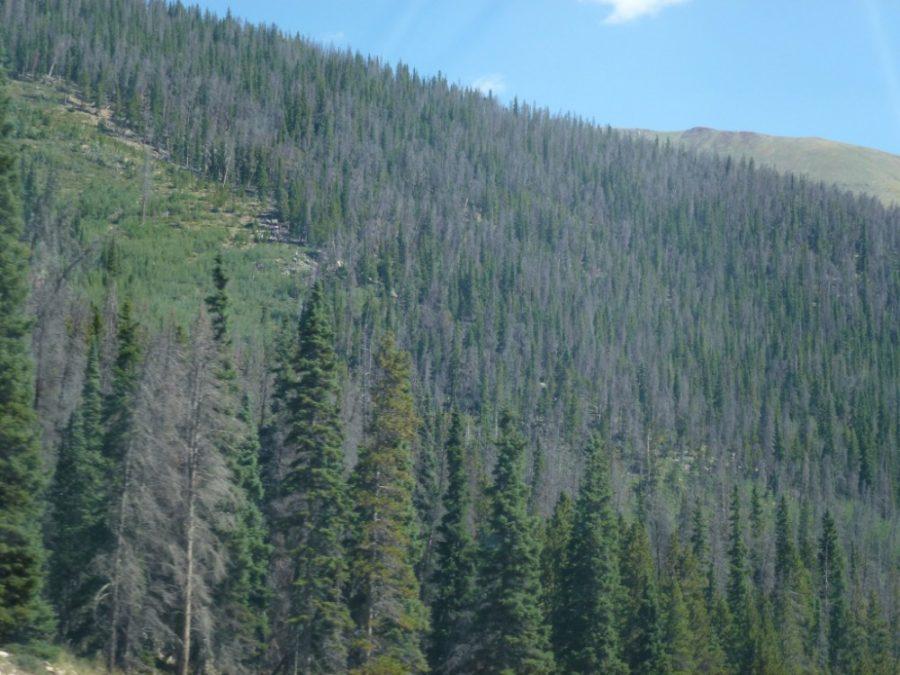A team of researchers across several universities recently demonstrated that forest die-offs can have dramatic effects on ecosystems continents away.
Acres of forests across the country, particularly in the Four Corners area of the Southwest, are dying in great numbers. Research revealed that the cause of this anomaly is a combination of two factors: an unusually warm drought, dubbed a “global-change-type drought,” and beetles that weaken trees by eating them.
The project was collaborative, featuring faculty from the UA, the University of Washington and Michigan State, each with their own specialty. Atmospheric sciences postdoctoral researcher Elizabeth Garcia from the University of Washington is credited with spearheading the project.
“The hotter droughts have become more devastating to the trees than a regular historical drought,” said Darin Law, senior research specialist from UA’s School of Environment and Natural Resources, who aided in the project. “Beetles like warmer weather, so they produce more and then the trees get more stressed out.”
RELATED: Featured Science: Critical Zone Observatory explores earth, atmosphere
The combination of a severe lack of water and the overwhelming number of beetles leaves the trees unable to support themselves. The most likely cause of the more severe droughts is climate change.
This anomaly is occurring across the globe and has led to the study on how these mass forest die-offs can affect other ecosystems. “The study was model based,” said David Breshears, a UA professor in the School of Natural Resources and Environment, who was also involved in the project.
Computer simulations and models were used to determine what would happen if large amounts of forest were to be removed from an area without having to harm a living forest. Breshears and other researchers took trees out of different parts of the United States and the Amazon to discover and understand different responses.
“We get different responses if we lose trees in more than one area,” Breshears said.
The simulated tree loss had an impact on plants elsewhere, ranging from positive to negative. What type of impact tree loss will have, however, is difficult to predict.
“One plus one does not always equal two, in this case,” Breshears said.
The effects were likened to that of El Nino—a recurring, abnormally warm ocean current in the Pacific that altered the environment in South America. Ecosystems around the world are affected by one another, and this connection, referred to as “ecoclimate teleconnections,” are becoming increasingly common and are likely to continue at the same scale.
Ecoclimate teleconnections have long-term consequences for the environment. One of the more prominent concerns is a decrease in gross primary production and the carbon supply on the planet. This could lead to less respiration among plants and a cooling effect due to fewer dark-colored trees absorbing the sunlight.
“That net cooling can have effects on water balance,” Law said. “And that water balance can have an effect on transpiration of trees and the amount of heat in the air.”
An increase in fire frequency and intensity is also noted as a dangerous repercussion, particularly in California—where a lack of moisture and large-scale forest die-offs are a very real concern. The forest die-offs may be preventable, though.
“The biggest issue that people are talking about now is trying to not put as many emissions into the ecosystem,” Law said. “I think that most people are focusing on clean energy and reducing carbon emissions.”
RELATED: Grasslands imperiled by climate change
Other efforts to prevent climate change include more sustainable infrastructure and the replanting of trees lost to drought. There are other studies currently investigating rising sea levels and how those may be affecting the environment. They may shed more light on how other factors contribute to changes in the ecosystem.
One of the lessons to be taken from the research is that the loss of forests in one place influences more than just the immediate ecosystem. The ecological effects can be far-reaching.
“If these types of die-offs continue and grow to a big enough scale, we’ll be impacting plants—not only where it happens, but in other places, too,” Breshears said. “It gives us a different sort of scale that we need to think about things at.”
Follow Nicole Morin on Twitter.















